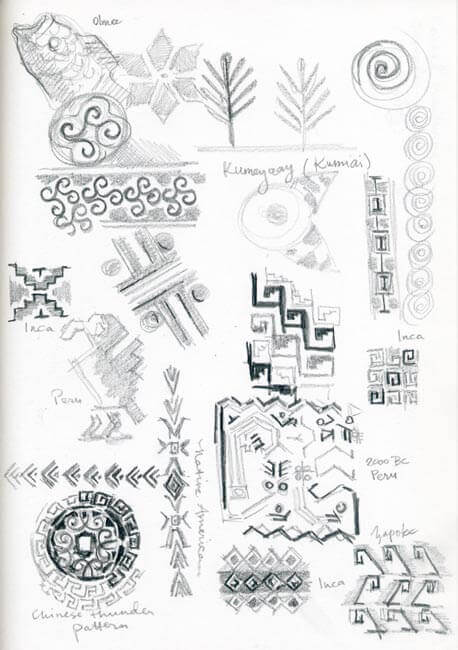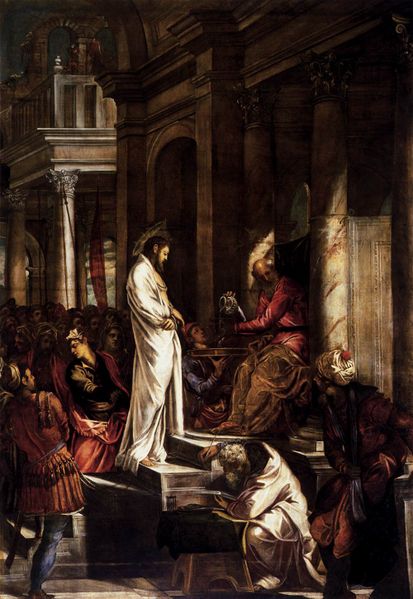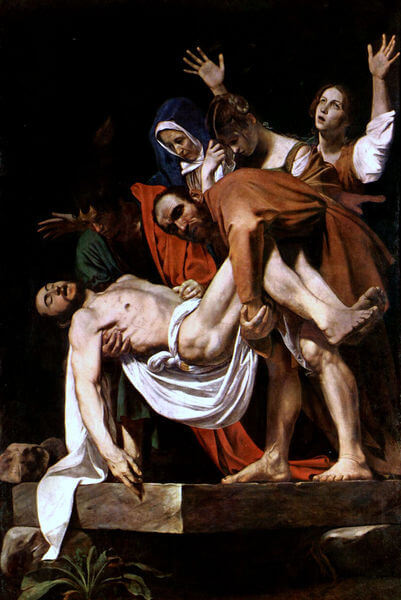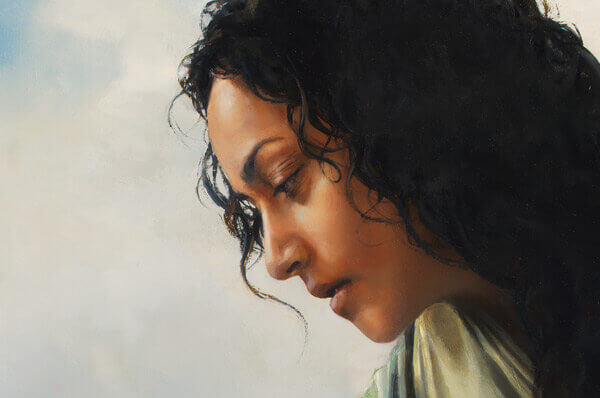Creating Dürer-like grasses and details
By Elspeth C. Young
Other Sheep I Have by Elspeth Young was completed in 2014 and is the 23rd painting in The Messiah Fine Art Collection.
Dimensions width x height
32.25 in. x 47 in.Support
Panel (prepared as described in Preparing a painting groundMilestones
Research begins - 2010 FebruaryComposition begins - 2014 April
Brushwork begins - 2014 May
Equipment
Creating a painting often involves creating or modifying tools or making improvements to the studio itself.Panel-support Accessory for A-Frame Easel
Clamp-on Brush Holders for Easel Framework
Costume, Props, and Miniatures
Creating a painting can also involve creative projects focused on setting, costume, props, and other features of the composition.Costume elements featured in this painting came from the Studios' costume storage.
Methodology
This section presents only one or two items that may be of interest to professional artists, amateurs, and others interested in the work of the Studios.For this project commentary, Elspeth provides the following excerpts from her journal for the project. They provide a very small sample of the kind and diversity of research involved in a project like this, a glimpse of the manifold considerations to be reconciled in the creation of such a painting, and a sense of the way in which an artist is self-taught through observation, research, experimentation, and inspiration.
May 2014
I got my creative battery recharged again today. The Sacred Gifts exhibit was extended two extra weeks and Mom and I dashed in for another last look. This time, I took a specific set of questions with me . . . . I plan to paint a woman feeling the prints of the nails in the feet of the resurrected Savior. I have a promising beginning, but discovered a list of questions as I worked out compositional elements, which I hoped Bloch, Schwartz, and Hoffmann could answer for me. After studying their paintings, here are some patterns of visual communication I noticed:1. The wounds in the Savior's feet are usually depicted at the epicenter of the foot.
2. Post resurrection wounds are circular, or longer slits like a knife thrust. Usually the artist paints a visual pattern of skin tone, highlight, pink-red wound, skin, highlight.
3. The brilliant light of the resurrected Christ's robes is best achieved against a dark background.
4. Highlights are the warmest hue and give a luminous glow with sometimes surreal lighting. This is sometimes accentuated by blue-gray shadows in the robe's folds.
5. Resurrected skin is generally painted whiter and shinier and smoother than the other skin in the painting. Lots of white glazes and blending are evident.
6. Sometimes, the resurrected Savior is painted as though He is emanating a creamy sunlight which reflects onto the objects and figures surrounding Him, as though His person were sunshine. Very effective.
 |
| A page of Elspeth's sketch-studies of selected traditional ancient American motifs found in material cultures from North and South America typify her attention to research and detail for such aspects of each painting. |
June 2014
I am knee-deep in the brushwork for a painting of a Lamanite woman touching the feet of the Savior . . . My excitement is hard to contain . . . Did you know that Mexican skin is nothing but cadmium yellow?July 2014
For three weeks now, my studio has been scented with the musk of linden blossoms . . . The midsummer heat is here, but my studio catches every caressing breeze [and] my Lamanite painting is leaping forward in development . . . My most satisfying painting session on it happened two weeks ago. After a long day, I hazarded some hours spent slapping some paint about, attempting to make sense of the marble foreground, and adapting the woman's skirt to better suit a purer visual statement devoid of distracting pattern. (It had been my intention to paint a red and gold Native American-inspired border running along the woman's skirts, but alas! Such comfort for my pattern-fractal-longing-soul will have to wait: Plain is purest.) I have rarely enjoyed such a painterly (yet precise) painting session. I knifed, I brushed, I ragged, and wiped away. The painting emerges. |
| Tintoretto's painting of the Savior before Pilate inspired Elspeth's conceptualization of the Savior's robes in Other Sheep I Have. |
 |
| The Entombment of Christ by Caravaggio was one of many Renaissance artworks that Elspeth studied during the creation of her own painting. |
August 2014
I've been too busy painting to write anything down. My studio feels like a hive, more than anything else . . . I have fabric from which to paint from life piled about (it takes quite a nack to ensure my palette and brushes don't interfere with antique linens as they reside on the same window sill—already a jumble of papers, diaries, and equipment). It took starting-over twice, but I have a beautiful resurrected foot in the Lamanite painting. I puzzled initially, since resurrected beings have bodies of flesh and bone (not blood), whether or not to include veining and the coloration of mortal skin to endeavor to depict resurrected glory, but nothing except real flesh and blood certainty looked visually stunning enough (my other attempts looked insipid). I have worked from about a dozen images of feet from life, paintings, and sculptures to produce the ideal foot. Michaelangelo, Caravaggio, as well as cadavers have all aided my quest. In reality, it was my brother's foot (with some painterly plastic surgery) in the toe shape's basic structure. The rock beneath the Savior's feet is a modified version of a large decorative rock next door—very handy. Pattern-hungry me is pleased to have sneaked back-in a two-tone pattern into the woman's outer wrap. While the dress itself needed purity, without any pattern, the woman was turning completely brown. I have to finalize motifs, but am excited at the suggestion I have blocked-in with siennas and golds. I did my final session, painting the woman's face yesterday. It is a symphony in sienna. (Unfortunately, I imagine most people would classify it as orange.) In reality, it is a striking orchestration of burnt sienna, cadmium yellow, quinacridone rose, raw umber, scarlet, white, and ochre (with flecks of pale blue, yellowed chromium oxide green, and pinky-quinacridone.) At Dad's suggestion, I am now painting my Lamanite woman in a wildflower-ish meadow, rather than the wasteland and dirt-rock-flora-thing I had planned after my marble foreground was painted-over.September 2014
My Lamanite painting changed and morphed and changed again in drastic ways before its completion in late August. After two more attempts at color changes, decorative pattern alterations and inventions, I completely repainted the woman's silk robe. The result matched the original folds in the sienna-colored sari used for the drape in the photo shoot with the model, but the color (and a few additional folds beneath the woman's right hand) were all painted from life, inspired by a sea-green skirt I purchased last year at Target (of all places). Apparently, after researching early Native American cultures, I discovered they used lichens to dye fabrics to just such a color, so we were both aesthetically pleasing (solving the woman-is-all-brown problem) and historically accurate. The Savior's robes were painted from an a-line linen skirt we had in costume storage. (That was a trick!) In an attempt to visually convey glowing fabric when I painted it, I removed all shadows and most of the midtones in the hopes of communicating the appropriate otherworliness. While doing the wildflower meadow in the foreground, I discovered how to create Dürer-like grasses and details:1. Block-in alla prima.The result allows very delicate lines.
2. Paint a medium-opacity glaze-layer over the area in a dark hue (payne's gray or something).
3. Paint grasses and blooms wet-into-wet.
Tags: Other Sheep I Have, 2014, Project commentaries, Tips and techniques
Browse articles by year: 2025 . 2024 . 2023 . 2022 . 2021 . 2020 . 2019 . 2018 . 2017 . 2016 . 2015 . 2014 . 2013 . 2012 . 2011 . 2010 . 2009 . 2008 . 2007 . 2006 . 2005 . 2004 . 2003 . 2002 . 2001 . 2000 . 1999 . 1998 . 1997 . 1996
Browse articles by topic: Art lessons . BenHaven Archives . Blank art diaries . Fine art photography . Framing . Illustration . Inspiration and creativity . Isles of Rune . Limited Editions Collection . My Fathers Captivity . News . Novellas . Oil paintings and prints . Operations announcements . Orders and shipping . Overview . Portfolios . The Papers of Seymore Wainscott . Project commentaries . Recipes by Nancy Young . Recommended reading . Recommended viewing . Temple artworks . The Storybook Home Journal . Tips and techniques . Tools supplies and operations
Browse articles by topic: Art lessons . BenHaven Archives . Blank art diaries . Fine art photography . Framing . Illustration . Inspiration and creativity . Isles of Rune . Limited Editions Collection . My Fathers Captivity . News . Novellas . Oil paintings and prints . Operations announcements . Orders and shipping . Overview . Portfolios . The Papers of Seymore Wainscott . Project commentaries . Recipes by Nancy Young . Recommended reading . Recommended viewing . Temple artworks . The Storybook Home Journal . Tips and techniques . Tools supplies and operations
